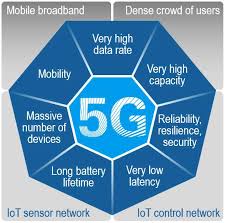What is 5G?

© copyright cdn.rohde-schwartz.com
5G is the latest generation of mobile phone technologies, following on from 4G. Indeed it is envisaged that 4G will work hand-in-hand with 5G in the initial phase prior to a stand alone 5G network. Even then the communications between 4G and 5G should be "seamless". The aim of 5G is to provide low latency and high capacity. However 5G is not just the next generation of mobile phone technology; it is more. The ITU defines 3 classes of 5G application eMBB (enhanced Mobile Broadband - essentially a better 4G); mMTC (Massive Machine Type Communications - to provide an massive IoT communication medium) and uTLLC (ultra Reliable Low Latency Communication - to support real-time applications). To this end there are different frequencies to be used to enable these different application types.
There are two significant aspect to any mobile network, the radio access network (RAN) and the core. 5G is design with virtualisation at the heart, so many of the radio network and core operations are virtualised and implemented on a cloud infrastructure. This speeds things up from a hardware a server based network. For 5G:
- RAN - uses a new interface, 5G NR (or new radio). Within this 2 standards
are defined FR1 and FR2;
- FR1 - this is an extension from the existing networks utilising frequencies less than 6GHz. This supports macro-cells. Currently in UK the 3.4 frequency has been auctioned off, with the 700MHz frequency to be auctioned soon. These frequencies are similar to, and have the same qualities as current frequencies used in 2G / 3G / 4G.
- FR2 - this is mmWave frequencies working between 24GHz and 100Hz. The UK has plans to release 26GHz in this area but no date has been given. This standard will support small cells usually in clusters. No previous mobile network uses similar frequencies
- Core - this is designed with better integration with the Internet. Remember that in 2G / 3G the prime connection was with the phone network, only 4G used the Internet as the prime communication medium. Rather than servers, the core has been re-designed to embrace cloud-systems allowing more servers to be nearer. Many of the previous network hardware functions are replaced by network hardware virtualisation i.e. software.
5G will support network slicing. This means that an operator will be able to run virtual networks over their real network; thus dedicating part of the spectrum to specific needs. For example the control of autonomous vehicles has a different requirement than viewing a 4K video. Different virtual networks will be available, maybe not to the public but for big inductrial businesses to purchase.
4G provided (some) MIMO technology on the network. 5G uses this extensively in Massive MIMO (multiple input multiple output). So the data is sent and received over a number of channels to achieve the speed necessary. Devices may only use one channel, or maybe a few but the aggregation of this in the base station via the mast mean it will support 100s of channels.
A number of radio technologies are used, beam forming and beam steering, to direct the antenna towards the user. Current antenna will work over a 120deg sector with some of the capacity directed to open fields. beam forming and beam steering allows the signals to be directed to traget the users and this can be carried out dynamically - in real-time.
The ultra high frequencies used in mmWave signals, providing ultra high urban capacity, will need many masts within these urban areas and mobile operators are seeking to attach masts onto street furniture making 5G a ubiquitous urban network. One main feature within 5G technology is the management of the interaction and handover between these small cells, and between small and macro cells.
*u* ©mobilephonetechnology.co.uk all rights reserved 2017- 2025



